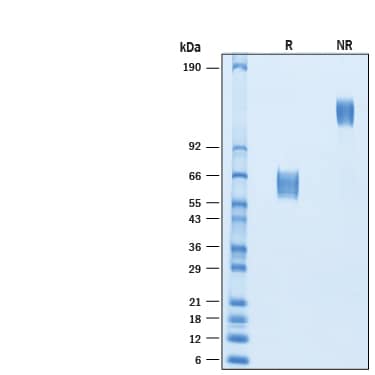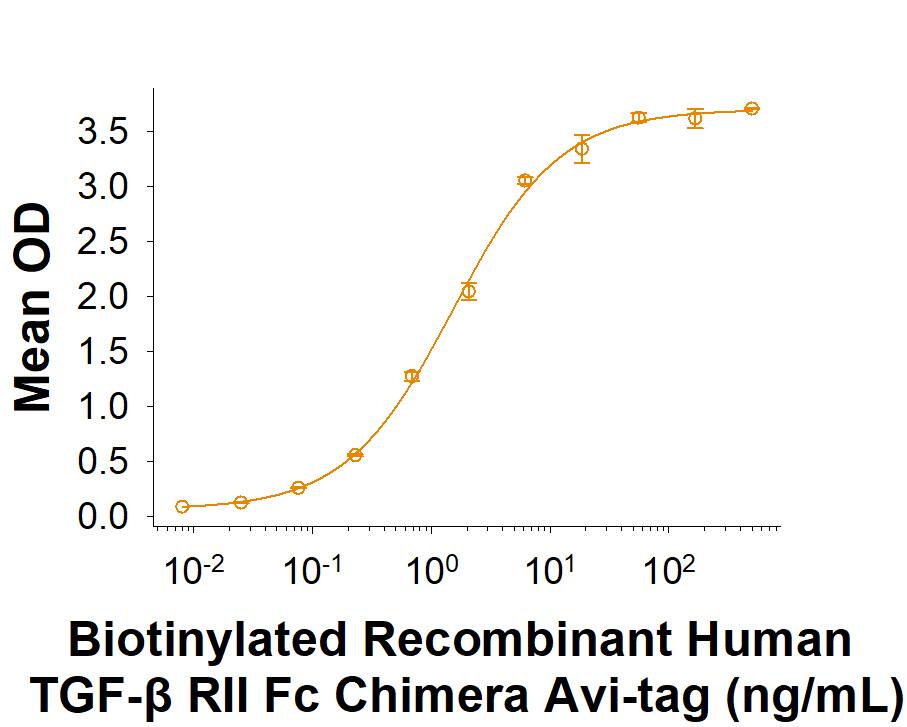Recombinant Human TGF-beta RII Fc Avi-tag Biotin Protein, CF
R&D Systems, part of Bio-Techne | Catalog # AVI341

Key Product Details
Source
Accession #
Structure / Form
Conjugate
Applications
Product Specifications
Source
| Human TGF-beta RII (Thr23-Asp159) Accession # P37173.2 |
IEGRMD | Human IgG1 (Pro100-Lys330) |
Avi-tag |
| N-terminus | C-terminus | ||
Purity
Endotoxin Level
N-terminal Sequence Analysis
Predicted Molecular Mass
SDS-PAGE
Activity
Scientific Data Images for Recombinant Human TGF-beta RII Fc Avi-tag Biotin Protein, CF
Biotinylated Recombinant Human TGF‑ beta RII Fc Chimera Avi-tag Protein Binding Activity.
When Recombinant Human TGF‑ beta1 (7754-BH) is immobilized at 0.2 µg/mL (100 µL/well), Biotinylated Recombinant Human TGF-beta RII Fc Chimera Avi-tag (Catalog # AVI341) binds with an ED50 of 0.2-1.6 ng/mL.Biotinylated Recombinant Human TGF‑ beta RII Fc Chimera Avi-tag Protein SDS-PAGE.
2 μg/lane of Biotinylated Recombinant Human TGF‑ beta RII Fc Chimera Avi-tag Protein (Catalog # AVI341) was resolved with SDS-PAGE under reducing (R) and non-reducing (NR) conditions and visualized by Coomassie® Blue staining, showing bands at 56-72 kDa and 110-140 kDa, respectively.Formulation, Preparation and Storage
AVI341
| Formulation | Lyophilized from a 0.2 μm filtered solution in PBS with Trehalose. |
| Reconstitution | Reconstitute at 250 μg/mL in PBS. |
| Shipping | The product is shipped at ambient temperature. Upon receipt, store it immediately at the temperature recommended below. |
| Stability & Storage | Use a manual defrost freezer and avoid repeated freeze-thaw cycles.
|
Background: TGF-beta RII
Most cell types express three sizes of receptors for TGF-beta. These are designated Type I (53 kDa), Type II (70-85 kDa), and Type III (250-350 kDa). The Type III receptor, a proteoglycan that exists in membrane-bound and soluble forms, binds TGF-beta 1, TGF-beta 2, and TGF-beta 3 but does not appear to be involved in signal transduction. The Type II receptor is a membrane-bound serine/threonine kinase that binds TGF-beta 1 and TGF-beta 3 with high affinity and TGF-beta 2 with a much lower affinity. The Type I receptor is also a membrane-bound serine/threonine kinase that apparently requires the presence of the Type II receptor to bind TGF-beta. Current evidence suggests that signal transduction requires the cytoplasmic domains of both the Type I and Type II receptors. The recombinant soluble TGF-beta Type II receptor is capable of binding TGF-beta 1, TGF-beta 3, and TGF-beta 5 with sufficient affinity to act as an inhibitor of these isoforms at high concentrations. The soluble receptor also binds TGF-beta 2, but with an affinity at least two orders of magnitude lower. Binding of TGF-beta 1, TGF-beta 3, and TGF-beta 5 to the soluble TGF-beta Type II receptor can also be demonstrated by using the soluble receptor as a capture agent on ELISA plates and this observation has been used as the basis for the development of immunoassays for these isoforms of TGF-beta. Our Avi-tag Biotinylated TGF-beta RII Fc Chimera features biotinylation at a single site contained within the Avi-tag, a unique 15 amino acid peptide. Protein orientation will be uniform when bound to streptavidin-coated surface due to the precise control of biotinylation and the rest of the protein is unchanged so there is no interference in the protein's bioactivity.
References
- Miyazono, K. et al. (1994) Adv. in Immunol. 55:181.
Long Name
Alternate Names
Gene Symbol
UniProt
Additional TGF-beta RII Products
Product Documents for Recombinant Human TGF-beta RII Fc Avi-tag Biotin Protein, CF
Product Specific Notices for Recombinant Human TGF-beta RII Fc Avi-tag Biotin Protein, CF
For research use only

